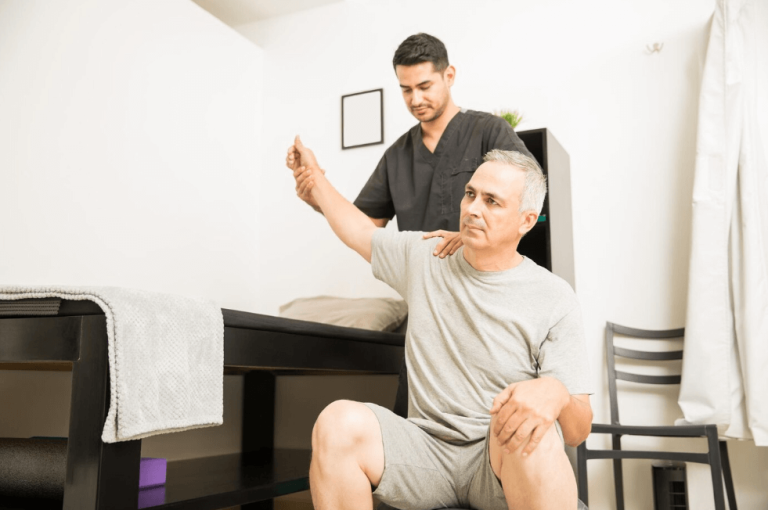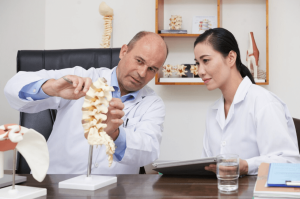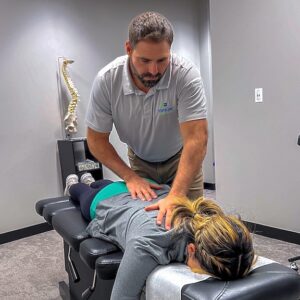Spinal stenosis, a condition causing the narrowing of the spinal canal, often leads to discomfort, pain, and limited mobility. Amidst various treatment options available, chiropractic care has gained recognition for its role in alleviating spinal stenosis pain. If you’re exploring chiropractic near you for relief, understanding the role of a chiropractor in managing spinal stenosis is crucial.
Understanding Spinal Stenosis:
Before delving into the chiropractic aspect, it’s essential to grasp what spinal stenosis entails. This condition involves the narrowing of spaces within the spine, leading to pressure on the nerves, resulting in pain, tingling, and numbness in the affected areas. While it’s commonly associated with aging, spinal stenosis can also result from other factors like injury or genetic conditions.

Role of Chiropractic Services in Alleviating Spinal Stenosis Pain:
Chiropractic care focuses on spinal adjustments and manipulations to address misalignments or subluxations in the spine. While spinal stenosis isn’t directly curable through chiropractic methods, the treatment aims to enhance the overall functionality and reduce discomfort associated with the condition.
Chiropractors employ various techniques tailored to individual patient needs. These may include:
Spinal stenosis, characterized by the narrowing of spaces within the spine, can result in nerve compression, leading to pain, tingling, numbness, and reduced mobility. While chiropractic care near me does not offer a cure for spinal stenosis, it plays a significant role in managing the associated pain and discomfort.
Spinal Adjustments:
At the core of chiropractic care lies spinal adjustments or manipulations. Chiropractors use their hands or specialized tools to apply controlled force to specific spinal joints, aiming to improve spinal alignment. By doing so, they seek to alleviate the pressure on nerves caused by spinal stenosis. These adjustments aim to restore normal motion in the spine, potentially reducing pain and enhancing overall mobility.
Chiropractic adjustments are tailored to individual patient needs. They are often gentle and precise, ensuring that patients feel comfortable during the procedure. Through a series of adjustments, chiropractors aim to gradually improve spinal alignment and alleviate the symptoms associated with spinal stenosis.
Decompression Therapy:
Another technique commonly employed by chiropractors for spinal stenosis is decompression therapy. This non-invasive treatment involves gentle stretching of the spine, using a traction table or specialized devices. The goal is to create negative pressure within the spinal discs, potentially relieving pressure on the nerves. By increasing the space between vertebrae, decompression therapy may reduce the discomfort caused by spinal stenosis.
Therapeutic Exercises:
Chiropractors often prescribe specific exercises designed to strengthen the muscles supporting the spine. These exercises focus on improving flexibility, stability, and overall spinal health. Strengthening the muscles around the affected area can help reduce the stress on the spine, potentially easing the symptoms of spinal stenosis and improving functional abilities.
Lifestyle Modifications:
Chiropractors emphasize the importance of lifestyle modifications in managing spinal stenosis. They may recommend ergonomic adjustments, such as proper sitting and standing techniques, to reduce strain on the spine. Additionally, guidance on posture correction and nutritional advice may be provided to support spinal health. These lifestyle modifications complement chiropractic treatments and contribute to long-term spinal wellness.
Comprehensive Approach:
Chiropractors often adopt a comprehensive approach to spinal stenosis management. This approach may involve collaborating with other healthcare professionals, such as physical therapists, orthopedic specialists, or pain management experts. By integrating various therapies and expertise, chiropractors aim to provide holistic care tailored to the unique needs of each patient.
Soft Tissue Therapy:
Chiropractic care often involves a spectrum of soft tissue therapy techniques aimed at addressing muscular tension and tightness surrounding the spine. These methods encompass diverse modalities such as targeted massage, myofascial release, or trigger point therapy. Soft tissue therapy focuses on easing the strain in muscles, tendons, and ligaments around the affected area.
By employing these techniques, chiropractors aim to enhance blood circulation, reduce inflammation, and promote the relaxation of tight muscles. Soft tissue therapy complements spinal adjustments by targeting areas of muscular stiffness and discomfort. It aids in restoring flexibility, reducing muscle spasms, and alleviating the secondary effects of spinal stenosis.
Electrical Stimulation:
Chiropractors frequently integrate electrical stimulation into their treatment plans for spinal stenosis. This therapy involves using electrical currents to stimulate nerves and muscles in the affected area. By doing so, electrical stimulation aims to modulate pain perception, decrease muscle spasms, and promote healing.
Through the application of electrodes, chiropractors deliver controlled electrical impulses to targeted tissues. This therapy aids in increasing blood flow, reducing inflammation, and stimulating the release of endorphins, the body’s natural pain-relieving hormones. Electrical stimulation can also enhance muscle strength, supporting the rehabilitation process for individuals managing spinal stenosis.
Customized Treatment Plans:
Chiropractors design individualized treatment plans tailored to the unique needs of each patient. These comprehensive plans are developed following a thorough assessment that considers the patient’s medical history, current symptoms, and physical examination findings.
Based on this evaluation, chiropractors create personalized strategies that may encompass a blend of chiropractic adjustments, specific therapeutic exercises, modalities like decompression therapy or electrical stimulation, and lifestyle recommendations. These tailored plans aim to address the root causes of spinal stenosis symptoms and facilitate optimal recovery.
Pain Management Techniques:
Chiropractors employ various pain management techniques beyond spinal adjustments to alleviate discomfort associated with spinal stenosis. These techniques include heat or ice therapy, ultrasound, or cold laser therapy. Heat therapy aids in relaxing muscles, increasing blood flow, and reducing stiffness, while cold therapy helps in numbing the area, reducing inflammation, and alleviating pain.
Ultrasound therapy involves using high-frequency sound waves to stimulate tissues deep within the body. It aims to enhance blood flow, reduce inflammation, and promote tissue healing. Cold laser therapy, also known as low-level laser therapy, utilizes focused light to stimulate cell regeneration, reduce pain, and accelerate the healing process in the affected area.
Patient Education:
An integral part of chiropractic care near me involves educating patients about their condition and empowering them with knowledge and self-care techniques. Chiropractors play a pivotal role in providing comprehensive information about spinal stenosis, its causes, symptoms, and potential treatments.
They guide patients on proper posture techniques, ergonomic modifications at home or work, and strategies for managing pain and discomfort between appointments. Patient education fosters an active role in self-management, enabling individuals to make informed choices and actively participate in their recovery process.
Regular Progress Evaluations:
Chiropractors routinely conduct assessments to monitor a patient’s progress throughout the treatment course. These evaluations involve tracking improvements in mobility, reduction in pain levels, and changes in the overall condition. By regularly evaluating progress, chiropractors can make informed decisions about adjusting the treatment plan to ensure optimal outcomes for their patients.
Adjustments to the treatment plan may include modifications in the frequency or type of chiropractic adjustments, the incorporation of additional therapeutic modalities, or changes in exercise routines. This continual evaluation and adaptation of the treatment plan aim to address the evolving needs of individuals managing spinal stenosis.
Holistic Approach to Wellness:
Chiropractic care often emphasizes a holistic approach to wellness, going beyond merely treating the symptoms of spinal stenosis. Chiropractors focus on promoting overall health and well-being by addressing various aspects of a patient’s lifestyle and health habits.
In addition to spinal adjustments and therapeutic techniques, chiropractors provide guidance on nutrition, stress management techniques, and other lifestyle adjustments. This comprehensive approach supports the body’s natural healing processes and encourages patients to make positive changes that contribute to long-term spinal health and overall wellness.
Long-Term Management:
Chiropractors emphasize the significance of long-term management and maintenance care for spinal health, even after experiencing relief from spinal stenosis symptoms. Following the initial phase of treatment, patients are encouraged to continue periodic chiropractic visits for maintenance care.
These regular visits aim to prevent potential flare-ups, maintain spinal alignment, and promote overall health. Maintenance care often involves periodic adjustments, continued exercises, and ongoing lifestyle recommendations tailored to support spinal health and minimize the risk of recurrence or worsening of spinal stenosis symptoms.
Choosing the Right Chiropractor:
When seeking chiropractic services, finding the right practitioner is crucial for effective management of spinal stenosis pain. Look for qualified professionals with experience in treating spinal conditions. Websites like Evolve Chiropractic West Schaumburg offer insights into services provided, testimonials, and professional backgrounds, aiding in making an informed decision.
While chiropractic care isn’t a cure for spinal stenosis, it can significantly contribute to managing associated pain and discomfort. Chiropractors play a pivotal role in offering personalized treatments to alleviate symptoms, enhance spinal health, and improve overall well-being. If you’re considering chiropractic services near you for spinal stenosis, consulting a qualified practitioner, such as those at Evolve Chiropractic West Schaumburg, could provide valuable relief and support in managing this condition.
Remember, a comprehensive approach involving chiropractic care, along with other medical advice, can contribute to a more comfortable and active lifestyle, despite dealing with spinal stenosis.
2644 W Schaumburg Rd, Schaumburg, IL 60194, United States
847-278-1574
https://myevolvechiropractor.com/locations/chiropractor-west-schaumburg-il/





